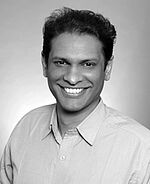
Group leader: Laboratory for Centrosome and Cytoskeleton Biology
Heinrich-Heine-University
Universitätsstraße 1 40225 Düsseldorf
Research Interests
Research at the laboratory for centrosome and cytoskeleton biology is mainly focused on translating basic research into clinical application. For clinical application, the laboratory has excelled in generating patient specific 3D-tissues such as iPSC-derived human brain organoids (“mini brains in dish”). Using these brain organoids, the laboratory addresses one of the fundamental questions in neurobiology, how neural stem cells are maintained to regulate the formation of structurally normal brain? To address this question, we engage in modeling microcephaly (patients with small brain), a neurodevelopmental disorder. Using patient-derived microcephaly brain organoids, we aim to pin point what are the critical cellular mechanisms underlie to form structurally and functionally normal brain.
Human brain organoids are also allowing us to model glioblastoma (GBM), a disastrous brain tumor for which no therapy is available. The laboratory has identified that cilia loss and aberrant centrosome numbers are the hallmarks of human cancers. By applying interdisciplinary approaches ranging from super-resolution imaging, electron microscopy, cell biology, structural biology and chemical biology, the laboratory has succeeded to identify small molecules that can effectively perturb GBM proliferation. Using these technologies, the laboratory is now trying to establish autologous experiments to understand invasive behavior of GBM cells in the same patient-derived brain organoids.
The laboratory is also uses human brain organoids in modeling Tauopathies, Alzheimer’s disease, neuroretinal degeneration and detrimental effects of environmental toxics on brain development.
Specific Projects
- Cytoskeleton mechanisms that regulate neural stem cell maintenance in brain development
- Molecular switches that determines proliferation or differentiation of neural stem cells
- Targeting those mechanisms to control over proliferation of glioma stem cells that have neural stem cell properties
- Modeling microcephaly and cortical malformations due to genetic mutations in centrosomes and cilia
- Modeling glioma infiltration in human brain organoids
- Autologous glioma invasion assays towards potential personalized experiments
Further information
Selected Publications
- Goranci-Buzhala G, Gabriel E, Mariappan A, Gopalakrishnan J* Losers of Primary Cilia Gain the Benefit of survival. Cancer Discovery 12, 1374-1375 (2017).
 PubMed
PubMed - Gabriel E, Gopalakrishnan J* Generation of iPSC-derived human brain organoids to model early neurodevelopmental disorders. J Vis Exp. 14;(122) (2017).
 PubMed
PubMed - Gabriel E, Ramani A, Karow U, Gottardo M, Natarajan K, Gooi LM, Goranci-Buzhala G, Krut O, Peters F, Nikolic M, Kuivanen S, Korhonen E, Smura T, Vapalahti O, Papantonis A, Schmidt-Chanasit J, Riparbelli M, Callaini G, Krönke M, Utermöhlen O, Gopalakrishnan J*. Recent Zika virus isolates induce premature differentiation of neural progenitors in human brain organoids. Cell Stem Cell 20, 1-10 (2017).
 PubMed
PubMed - Zheng X, Ramani A, Soni K, Gottardo M, Zheng S, Ming Gooi L, Li W, Feng S, Mariappan A, Wason A, Widlund P, Pozniakovsky A, Poser I, Deng H, Ou G, Riparbelli M, Giuliano C, Hyman AA, Sattler M, Gopalakrishnan J*, Li H*. Molecular basis for CPAP-tubulin interaction in controlling centriolar and ciliary length. Nat Commun 7, 11874 (2016).
 PubMed
PubMed - Gabriel E, Wason A, Ramani A, Gooi LM, Keller P, Pozniakovsky A, Poser I, Noack F, Telugu NS, Calegari F, Šarić T, Hescheler J, Hyman AA, Gottardo M, Callaini G, Alkuraya FS, Gopalakrishnan J*. CPAP promotes timely cilium disassembly to maintain neural progenitor pool. EMBO Journal. Apr 15;35(8):803-19. (Cover article) (2016).
 PubMed
PubMed - Zheng X, Gooi LM, Wason A, Gabriel E, Mehrjardi NZ, Yang Q, Zhang X, Debec A, Basiri ML, Avidor-Reiss T, Pozniakovsky A, Poser I, Saric T, Hyman AA, Li H*, Gopalakrishnan J* Conserved TCP domain of Sas-4/CPAP is essential for pericentriolar material tethering during centrosome biogenesis. PNAS, Volume 111, Number 3. (2014).
 PubMed
PubMed - Avidor-Reiss T, and Gopalakrishnan J Building a centriole. Curr Opin Cell Biol; S0955-0674(12)00180-9. (2013).
 PubMed
PubMed - Gopalakrishnan J, Chim YC, Ha A, Basiri ML, Lerit DA, Rusan NM, and Avidor-Reiss T (2012). Tubulin nucleotide status controls Sas-4-dependent pericentriolar material recruitment. Nat Cell Biol 14, 865-873.
 PubMed
PubMed - Gopalakrishnan J, Mennella V, Blachon S, Zhai B, Smith AH, Megraw TL, Nicastro D, Gygi SP, Agard DA, and Avidor-Reiss T (2011). Sas-4 provides a scaffold for cytoplasmic complexes and tethers them in a centrosome. Nat Commun 2, 359.
 PubMed
PubMed - Gopalakrishnan J, Guichard P, Smith AH, Schwarz H, Agard DA, Marco S, and Avidor-Reiss T (2010). Self-assembling SAS-6 Multimer Is a Core Centriole Building Block. Journal of Biological Chemistry 285, 8759-8770.
 PubMed
PubMed


